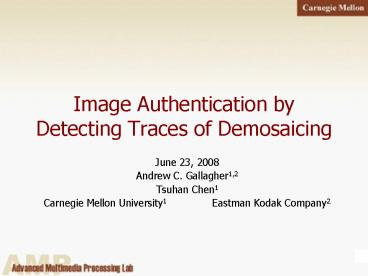Image Authentication by Detecting Traces of Demosaicing - PowerPoint PPT Presentation
1 / 20
Title:
Image Authentication by Detecting Traces of Demosaicing
Description:
We show results on forgeries created from real digital camera images. ... Virtual Camera. Lens. CFA Interpolation. Digital Cameras Use Color Filter Arrays ... – PowerPoint PPT presentation
Number of Views:363
Avg rating:3.0/5.0
Title: Image Authentication by Detecting Traces of Demosaicing
1
Image Authentication by Detecting Traces of
Demosaicing
- June 23, 2008
- Andrew C. Gallagher1,2
- Tsuhan Chen1
- Carnegie Mellon University1 Eastman
Kodak Company2
2
The Problem Authentication
- Good News Computer Graphics and Image
Manipulation tools are rapidly advancing.
- Bad News How can we confirm that an image is
authentically captured by a digital camera?
Image Credit Columbia photographic images and
photorealistic computer graphics dataset.
3
Computer Graphic vs. Photographic
Photo-Realistic Computer Graphics (PRCG)
Photographic Images (PIM)
Image Credit Columbia photographic images and
photorealistic computer graphics dataset.
4
Local Forgeries
Authentic image
Locally Modify Content or insert newContent
(Photographic or PRCG)
Locally Forged Image
5
Goals and Approach
- Our Goals
- Distinguish between Photographic (PIM) and
Computer Graphic (PRCG) - Find and Localize Forgeries
- Our Approach
- We focus on the image processing differences
between digital cameras and computer graphics. - We detect local traces of CFA interpolation.
6
Contributions
- PIM versus PRCG
- Hardware specific features vs. image physics or
texture features (Ng et al. 2005, Lyu and Farid
2005) - Finding the demosaicing parameters is not
necessary. (vs. learning with EM as in Popescu
and Farid 2005). - Excellent (best) performance on a standard test
set using interpolation detection. - We test with actual JPEG images from digital
cameras.
7
Contributions
- Detecting Local Forgeries
- We show CFA detection is useful for accurately
localizing suspicious regions. - We show results on forgeries created from real
digital camera images. - The images are available for research.
8
Image Formation
- Digital Cameras
Sharpen Noise Cleaning
Hardware Correction
Balance Tone
Render
JPEG
A/D
Lens
Sensor
9
CFA Interpolation
CFA Interpolation
- Digital Cameras Use Color Filter Arrays
- Interpolation is required
- In general, missing pixels are a linear
combination of neighbors - Interpolation can be detected (Gallagher 2000,
Popescu and Farid 2005).
10
Detecting Traces of CFA Interpolation
Canon EOS JPEG
EstimateVariance
Detect PeakStrength
- CFA Traces survive camera processing(even
compression) - Peak Strength
11
PRCG versus PIM
PIM. Distinct Peak at w p
PRCG. No Distinct Peak at w p
12
Results PRCG vs. PIM
- Columbia Image Set
- 800 PIM Digital Camera Images (JPEGs)
- 800 PRCG Photorealistic Computer Graphic
- Previous Approaches
- Texture statistics (wavelets) Lyu and Farid
(2005) - Geometric and Physical Features Ng et al. (2005)
- Our Feature Peak Strength
13
Results PRCG vs. PIM
- Performance as a function of region size
14
Results PRCG vs. PIM
- JPEG Quality Factor
Quality Factor 99
15
Results PRCG vs. PIM
- JPEG Quality Factor
Quality Factor 20
16
Results PRCG vs. PIM
- Classification Errors
PIM misclassified as PRCG
PRCG misclassified as PIM
17
Detecting Local Forgeries
Canon EOS JPEG
EstimateVariance
Detect PeakStrength
- Peak is computed locally (64x256)
- Forged regions usually wont have CFA traces.
- Suspicious regions have low .
18
Localizing Forgeries
SuspiciousRegions
Authentic
Forged
Analysis
Good results on all three images.
Images are Available at http//amp.ece.cmu.edu/pe
ople/Andy/authentication.html
19
Discussion
- CFA traces are destroyed by resizing
- CFA interpolation could be forged by a
sophisticated forger. - Many tests will likely be necessary to detect
forgeries.
20
Conclusions
- We propose an elegant CFA interpolation detection
for - Distinguishing PIM from PRCG
- Localizing forged image regions
- Recovering the CFA parameters is not necessary.
- Our results are the best yet on a standard image
set.































